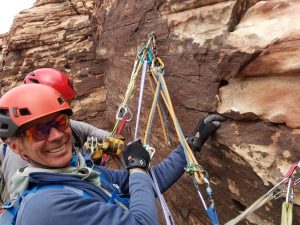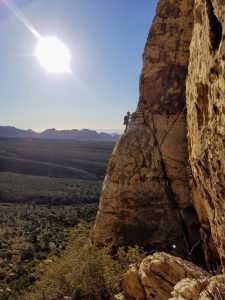Expanding Skills on the ARGC – Zeb Blais
2019 ARGC Fallen Guides Testimonial – Zeb Blais

“Off Belay!” – Before the words had a chance to echo off the steep rock above, the rope at our feet was moving. And fast. I finished tying the laces of my rock shoes just in time to feel the rope come tight on my harness. “That’s me!” One, two, three, four, five…before I could reach ten, the “on belay” command came down- it was time to climb.
I moved fast, testing the belayer to keep up. Try as I might, the rope kept up with me. It didn’t loop at my feet or slap me violently in the face, it slithered like a snake up the rock in front of me. When I arrived at the belay, I wasn’t where I was expecting to be. The guide book clearly showed the top of the first pitch up another 75’. I couldn’t argue. The stance was incredibly comfortable for us as the clients, and it appeared that our instructor, Art Mooney, was quite at home as well.
His piles of rope were stacked in a messy looking pile, but things were happening fast. He employed a Connecticut hitch to anchor me and Brandon, the other participant, to a nearby tree. The once-messy pile of rope transformed into a perfect stack before we had time to think much about the conversation Art was engaging us with. He took the gear we had cleaned, had Brandon put him on belay, cleaned the anchor he had used to belay us, checked that he was on belay, and, without rushing, began the next pitch. Done. Up an out.
The rest of our instructor led climb went similarly. Smooth, thoughtful movement and efficiency were clearly the themes and it really set the tone for the course and made a great impression of how a professional rock guide should execute an objective.
The days leading to the Instructor Demo had been focused on techniques and guide tricks for improving efficiency, guide and client security and comfort. We had covered everything from Rock Rescue (one of the exam components of the program), belaying leaders and followers, using fixed point belays, anchor building, lowering, hauling, strategies for using multiple ropes and tag-lines, and short roping. All of these skills are necessary and useful and every minute of these days provided valuable new techniques or reinforcement of techniques that I had previously learned. These days are the core of the hard skills for this program, but I felt like I lucked out watching Art guide.
It was a certainly a highlight of this course and I internalized a lot by following him up that climb. It all seemed effortless to Art. Mistakes were minimal, but when twists did appear in the rope he calmly and quickly sorted it out and carried on. It was clear he expected these hiccups and his solutions were smooth and efficient. But it wasn’t just application of the hard skills. He also inserted a slew of soft skills. Despite his clients being aspiring rock guides, he played the role of guide perfectly, passing out helpful hints and sharing teaching techniques through example as we went. The climb showcased both hard and soft skills and provided a target to shoot for in my own guiding.













